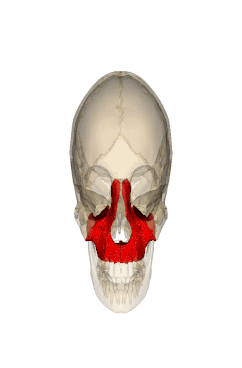 The maxlla is pictured here in red. It is a very important bone for the function of the body, and this includes TMJ/TMD problems. The maxlla is pictured here in red. It is a very important bone for the function of the body, and this includes TMJ/TMD problems. When people talk about Tempromandibular Joint (TMJ) problems or tempromandibular dysfunction (TMD), they are thinking of the actual joint. Indeed, the TMJ is a very important and complicated joint. People will feel pain in that area or hear popping or clicking. But the function of the joint is so dependent on other areas of the body! One such area is the maxilla. It's a bone in your head that you most likely haven't heard of, but it's the one your top teeth come from. It is what your jaw makes contact with every time you eat, drink, or swallow. The maxilla makes up the base of the anterior 2/3rds of the skull. If the relationship between the jaw and the maxilla is balanced, then they work together to help reinforce a properly functioning cranium and temporomandibular joint. However, if the position of the maxilla shifts, then you have the jaw (mandible) making contact with an unbalanced surface. I routinely check and correct issues with the maxilla in my office since it is important to everyone's general health. In TMJ, it becomes an especially important bone to give attention to because of its relationship to the jaw and its connection with other cranial bones in the body. These include the zygoma, frontal, nasal, palatine, lacrimal, ethmoid, nasal concha, and volmer. The position of the maxilla can affect the position of these other bones, which in turn connect to other parts of the body in a chain. A properly positioned maxilla can help keep a healthy body, but a distorted maxilla can cause all sorts of problems. For example, there is an intricate relationship between the position of the maxilla and the position of the C1 vertebra, or atlas vertebra. It is impossible to fully balance a C1 vertebra without balancing a maxilla. Another issue with the maxilla is a narrow palate. There is an association with a narrow palate and airway compromise, snoring, sleep apnea, and forward head posture. In infants, palate issues can relate to sucking and nursing issues. Chiropractic craniopathy can be quite effective in dealing with palate issues, especially in children as the palate develops. Sometimes the maxilla requires dental intervention to help support the cranial corrections being made at my office. A simple adjustment to the occulsion (the way teeth touch) by a dentist can stabilize the maxilla. The ALF (Advanced Lightwire Functional) is a thin wire that can be placed behind the teeth to help support cranial corrections through the maxilla. This needs to be done by a dentist with advanced training in ALF and lots of experience using it. Expansion of the maxilla will occur with an ALF, but unlike other "palate expanders", special care is given to make sure the expansion will reinforce stability in the cranium. My advanced training in chiropractic craniopathy gives me the skill to assess the maxilla and its relationship with other parts of the body. If you have a "TMJ" problem or TMD, I can evaluate the function of your maxilla and see if it is contributing to your problem. Please contact my office in Palm Harbor Florida to schedule and appointment.
0 Comments
Leave a Reply. |
AuthorI'm a Chiropractic Physician, Psychotherapist and researcher. I'm interested in helping people live their lives to their full potential. That could be simply without pain. Or it could be without more complicated physical or mental health problems. Or it could be getting help in making changes in their life so that they can achieve their dreams. Archives
June 2023
Categories |
 RSS Feed
RSS Feed